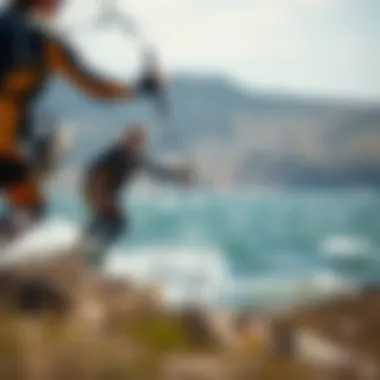The Original Slingshot: Exploring Its Impact on Kiteboarding


Intro
Kiteboarding is a sport that dances between the skies and the sea, demanding precision, skill, and the right equipment to keep things flying smoothly. Among the tools that enhance this adrenaline-fueled sport, the slingshot stands out as a crucial element in the engineering of kites. Understanding this device not only entails a journey through its historical origins but also an exploration of its influence on the modern kiteboarding experience.
This article aims to shed light on the various dimensions of slingshots, including their evolution from simple designs used by early adventurers to cutting-edge components engineered for optimal performance. The narrative is enriched by firsthand accounts from seasoned kiteboarders, safety tips, and a discussion of environmental considerations that leave a mark on both the rider and the ecosystem.
As we make our way through the pages of this exploration, focus on the significance of gear selection and skill development. Both facets are interconnected, laying the groundwork for mastering the art of kiteboarding.
So strap in as we dive deep into the world of slingshots and kiteboarding—where every detail counts and every experience shapes our understanding of this exhilarating sport.
Preamble to the Slingshot
The slingshot, while often linked to playful nostalgia, plays a pivotal role in the world of kiteboarding, acting as a bridge between beginner and advanced riding. It's not just a piece of equipment; it embodies the spirit of the sport—freedom, innovation, and a touch of rebellion. Understanding the slingshot is essential for any kiteboarding enthusiast, as it serves as a primary tool for launching and controlling the kite in diverse wind conditions.
This introduction sets the stage for exploring how the slingshot enhances the kiteboarding experience, allowing riders to harness the wind's power. The design and mechanics of the slingshot, which will be detailed further in this article, are crucial for achieving optimal performance on the water.
Key Elements of the Slingshot:
- Control: The slingshot allows for precise adjustments to kite position, essential for maintaining stability and power.
- Launch: A proper understanding and use of the slingshot can significantly improve launch techniques, giving riders that exhilarating lift as they shoot skyward.
- Safety: Familiarity with the slingshot ensures a safer experience, helping riders avoid common pitfalls associated with launching or landing their kites.
The benefits of mastering the slingshot are manifold. Riders gain not just control but confidence. As they learn to read the wind and manipulate their kite's behavior, they develop a connection not only to the equipment but also to the elements themselves. In essence, the slingshot is more than just gear; it's a key player in the dance between rider and nature.
As we delve deeper into the history and design of the slingshot, we will uncover its significance across different contexts. With this foundation, we embark on exploring its various aspects, all of which contribute to a fuller understanding of this essential kiteboarding tool.
"A well-timed slingshot can feel like a secret weapon, turning a regular ride into a thrilling adventure."
As this article unfolds, we will dissect the evolution of the slingshot, the materials that make it effective, and its numerous applications in kiteboarding, ensuring that every rider—whether just starting or seasoned—can benefit from this comprehensive exploration.
Historical Background
The historical background of the slingshot in kiteboarding is crucial for understanding its significance today. This section digs into the roots of this remarkable tool, painting a vivid picture of how its past shapes the present and future of kiteboarding. By exploring both ancient uses and its evolution over time, we uncover the layers of craftsmanship and innovation that have culminated in the modern slingshot, an instrument that represents not just functionality but also a rich cultural heritage. Understanding these components allows modern enthusiasts to appreciate the artistry involved in their sport and respect the legacy passed down through generations.
Ancient Uses of Slingshots
In ancient cultures, slingshots were hardly the playful toys we might envisage. These ingenious devices were primarily employed as tools for hunting and warfare. For instance, in ancient Greece, people utilized slingshots fashioned from leather and string to hurl stones with impressive force. This level of utilization demonstrates how crucial such tools were for survival. Notably, the biblical account of David and Goliath highlights a legendary leap in slingshot usage and skill, cementing their importance in historical narratives.
In the realm of non-war pursuits, these devices also played a role in leisure activities. Children across various cultures adapted them for play, using natural resources found nearby like rubber bands for elasticity and flexible branches for structure. Thus, while slingshots served practical purposes, they also acted as a means of entertainment, shaping the social fabric of community life. Much like kiteboarding today, they became a medium through which skills could be honed, camaraderie could be fostered, and stories could be told.
Evolution Over Time
As we leapfrog through centuries, the evolution of the slingshot mirrors technological advancements in material science and design practices. By the late 19th and early 20th centuries, rubber became the material of choice, revolutionizing not just durability but also the range and power of the shot. The amalgamation of wood, rubber, and later, synthetic materials like fiberglass, paved the way for modern slingshots found in kiteboarding equipment today.
However, the transition was not purely a product of innovation. Social trends influenced design as well. The mid-20th-century surge of kiteboarding’s popularity saw enthusiasts blending traditional elements with modern aesthetics. Designs became more user-friendly, prioritizing performance without sacrificing safety.
As kiteboarding evolved, so did the acceptance of diverse styles and methods in slingshot usage—showcasing a blend of artistry and function. In a world increasingly focused on sustainability, newer slingshots are crafted with eco-friendly materials, allowing kiteboarders to engage in their passion while respecting the natural environment. This continuous spirit of innovation reflects not only technological advancement but also a wave of collective consciousness within the kiteboarding community.
"The past is never dead. It's not even past." – William Faulkner
From ancient hunting grounds to waves of the modern coast, the journey of the slingshot in kiteboarding encompasses a myriad of stories and designs that have transformed it from a tool of necessity to an instrument of sport. As kiteboarders harness the powers of the wind, the legacy of the slingshot remains integral, urging us to understand and respect its varied past.
Understanding the Design
Understanding the design of the slingshot is crucial for kiteboarding enthusiasts as it directly influences performance, usability, and overall riding experience. A well-designed slingshot can enhance the flight of a kite, improve launching techniques, and ensure safety during excursions. By deep diving into the components and principles behind slingshot design, riders can make informed choices that boost their performance and enjoyment on the water.
Materials and Construction
When discussing the materials and construction of slingshots, what stands out is the diversity available today. Manufacturers use various materials, each bringing distinct benefits to the table. Common materials include plastics, composites, and high-strength fabrics.
- Plastic Components: Lightweight and often cost-effective, plastic is suitable for entry-level slingsots. They can withstand various weather conditions but might not provide the longevity some more serious kiteboarders seek.
- Composite Materials: These are a blend of different materials, designed to offer a balanced combination of strength and flexibility. Riders often prefer them due to their durability and overall performance reliability.
- High-Strength Fabrics: Many modern slingshots incorporate sails made from ripstop nylon or even ultralight polyester. These fabrics resist tearing and ensure durability while maintaining low weight for effortless maneuvering.


The construction process is equally important. A well-crafted slingshot has seamless stitching, robust frames, and evenly distributed tension points that contribute to its overall efficacy. Riders should look for features like reinforced corners and adequately sized pouches to avoid unexpected failures during high-performance scenarios.
Mechanics of the Slingshot
The mechanics of a slingshot operates on some essential principles that dictate how energy is stored and released. The functionality boils down to a few elements: the frame, the rubber bands, and the projectile placement.
The frame must be sturdy yet flexible. It needs to withstand significant forces without bending or breaking. This aspect is often overlooked but critical, especially during intense launches or when combating strong winds. Riders can often feel the difference in performance based on how rigid or flexible the frame is.
Next, the rubber bands or elastic components of a slingshot are the heart of its mechanics. Different types of rubber allow for varied degrees of stretch and recovery. Some setups allow for substantial stretch before release, enabling the rider to build up enough energy to send their kite skyward quickly. This is where physics comes into play:
- Potential Energy: As the rubber stretches, it stores energy.
- Kinetic Energy: Upon release, this stored energy converts to kinetic energy, propelling the projectile or kite upwards with force.
To enhance your understanding of these concepts further, consider the relationship between band thickness and launch speed. Thicker bands typically yield a more powerful launch but may require more skill to control effectively.
"The way a slingshot is engineered can determine not just a rider's performance but also their safety during kiteboarding. Choosing the right materials leads to better experiences on the water."
In summary, understanding the slingshot's design—its materials and mechanics—plays an imperative role for anyone engaged in kiteboarding. The less-seen aspects of construction can make all the difference between a thrilling ride and a frustrating one. Optimizing for these elements typically leads to not just better performance, but greater enjoyment out on the waves.
Practical Applications in Kiteboarding
The slingshot is more than just a tool; it’s the very backbone of kiteboarding. This seemingly simple device plays a crucial role in providing rider power and maneuverability, allowing both novices and experts to navigate the waters with precision and style. The significance of practical applications in kiteboarding cannot be overstated, as they encompass the essential techniques that enhance the overall kiteboarding experience. Let's explore how these applications unfold in practice and the myriad of benefits that they bring to riders.
Launching Techniques
One of the most vital practical applications of the slingshot in kiteboarding is the launching technique. A successful launch can set the stage for the entire session, translating into better performance on the water. The importance of mastering this technique goes beyond just getting your kite off the ground; it involves understanding wind conditions, timing, and the slingshot’s dynamic potential.
Here’s a rundown of effective launching methods:
- Solo Launch: When launching alone, it’s vital to utilize the slingshot correctly. You should position the kite at a slight angle to the wind. Hold onto the slingshot tightly while pulling the kite to a vertical stance before releasing gently. This method requires practice to perfect the timing, but it eventually allows for an effective self-launch without assistance.
- Assisted Launch: Having a buddy can make all the difference. With the slingshot in hand, one person stabilizes the kite while another pulls on the slingshot. This technique ensures that the kite does not flap uncontrollably in the wind, creating a smooth transition as it takes to the air.
- Positioning: Placement also plays a role. It is recommended to position oneself downwind to better control the initial lift of the kite away from the water's surface.
Each of these techniques is essential for various scenarios on the water. Mastery enhances rider confidence, minimizes accidents, and brings about a smoother start. Good launching practices can even make a sea of difference in conditions that might otherwise seem overwhelming.
Retrieving the Kite
Retrieving the kite after a session is just as crucial as launching it. Proper retrieval techniques harness the slingshot’s capabilities to ensure that a rider’s gear is brought back safely and efficiently. Understanding how to execute this step effectively can prevent wear and tear on the equipment and minimize the chance of accidents.
Here’s what to keep in mind:
- Downwind Approach: When retrieving your kite, aim to maneuver it downwind to streamline control. This tactic ensures that you’re not fighting the wind when bringing the kite back.
- Using the Slingshot: The slingshot should remain at the ready as you navigate back. As the kite descends, gradually pull on the slingshot to bring it safely to the ground. This action stabilizes the kite, preventing it from flapping about in the wind or ending up in the water.
- Technique Execution: Gently pull the kite closer while maintaining a clear focus on its positioning. If you allow the kite to hover above the surface, it can catch the wind unexpectedly and launch itself back up again.
In kiteboarding, effective retrieval practices are vital as they can dictate the longevity of the equipment and availability for future use. These two practical applications – launching and retrieving – encompass critical skills in every kiteboarder’s repertoire, shaping their overall riding experience. Knowing these techniques not only enhances performance but fosters a spirited appreciation for the sport's unique challenges and triumphs.
"Mastering the slingshot in kiteboarding is akin to learning to dance with the wind; it’s about harmony and confidence on the water."
Safety Considerations
Safety is paramount when it comes to kiteboarding, especially when utilizing the slingshot, which plays a pivotal role in launching and controlling the kite. Every kiteboarder, novice or expert, should grasp the significance of safety considerations to minimize risks and enhance the overall experience on the water.
Common Risks and Precautions
Kiteboarding naturally comes with its set of risks, and being aware of them is half the battle. Here are some predominant hazards associated with using a slingshot in kiteboarding:
- Accidental Launching: One of the most frequent mishaps occurs when the slingshot triggers an unintended launch of the kite. This can happen if the pilot mishandles the slingshot or if safety measures aren't observed.
- Collisions with Other Riders: In crowded waters, the likelihood of colliding with another rider escalates. This is where spatial awareness plays a crucial role.
- Equipment Failure: Components of the slingshot, such as elastic bands and connection points, can wear and tear over time. Regular checks can help detect issues before they lead to accidents.
To mitigate these risks:
- Always conduct a pre-launch safety check. Ensure that the slingshot is not only set up correctly but also that the kite lines and the kite itself are in good shape.
- Maintain communication with others around you. A few simple hand signals can alert fellow riders of your intentions.
- Stay updated on the weather conditions. Sudden gusts or changes can dramatically impact kiteboarding.
Remember: An ounce of prevention is worth a pound of cure. Taking time to assess your surroundings and equipment can save a lot of headaches later.


Protective Gear Recommendations
Wearing appropriate protective gear can immensely reduce injuries while kiteboarding. Here, we recommend essential items every rider should consider:
- Helmet: A vital piece of gear, not just for impact protection but also for keeping the head warm during chilly winds.
- Impact Vest: This can cushion blows and provide additional buoyancy. A good impact vest can be a lifesaver during an unexpected fall.
- Kiteboarding Shorts: These are designed to offer protection against board injuries while providing comfort during long sessions.
- Leash Systems: Commonly overlooked, a reliable leash can prevent loss of gear, especially in chaotic conditions. It also ensures the kite remains tethered to you in the event of a fall.
Environmental Impact
Understanding the environmental impact of kiteboarding tools like the slingshot is increasingly pertinent in today’s climate-aware world. Kiteboarding, while thrilling and adventurous, can potentially have negative effects on natural habitats if not approached with care and responsibility. Therefore, acknowledging these impacts and striving for sustainable practices is crucial, not just for the environment but also for the future of the sport itself.
As kiteboarding enthusiasts indulge in their passion, they often overlook how their activities may influence coastal ecosystems, marine life, and even air quality. Navigating biodiversity and ensuring that kiteboarding remains a low-impact pursuit demands that riders, instructors, and manufacturers reflect on their practices.
Sustainable Practices
Embracing sustainability in kiteboarding demonstrates a commitment to protecting the environment while enjoying the sport. Here are several effective sustainable practices:
- Eco-conscious Materials: Use gear made from recyclable or biodegradable materials. This shift not only reduces plastic waste but also encourages manufacturers to innovate in environmentally friendly ways.
- Leave No Trace: Adopting the Leave No Trace principles aids riders in keeping beaches and water bodies clean. Simple actions like picking up after oneself can make a great impact.
- Community Involvement: Join local beach clean-ups or conservation projects. Contributors can forge stronger ties with the environment and the community, helping raise awareness about the importance of protecting the coastline.
"Every little effort counts. It's about coming together to make a meaningful change in the world around us."
- Responsible Travel: When traveling for kiteboarding, considering the carbon footprint associated with transport can enhance sustainability. Opt for local destinations whenever possible to reduce emissions.
These practices underline a commitment to the planet, paving the way for the next generation of riders.
Promoting Eco-friendly Kiteboarding
Promoting eco-friendly kiteboarding involves education and collaboration among different stakeholders in the kiteboarding community. Here are ways to encourage and advocate for greener kiteboarding:
- Educational Programs: Workshops focused on the environmental aspects of kiteboarding educate both new and experienced riders about how their actions influence the environment. Knowledge is power when it comes to preserving nature.
- Support Eco-friendly Brands: Choose to purchase equipment from companies that prioritize sustainable manufacturing processes. Many brands now leverage greener methods that lower their carbon footprint.
- Advocating for Bans on Polluting Practices: Joining local or regional campaigns aimed at limiting harmful practices, such as using gas-powered boats for kiteboarding, can significantly contribute to reducing environmental degradation.
- Social Media Awareness: Utilize platforms like Facebook and Reddit to spread the word about eco-friendly kiteboarding practices. Sharing tips, personal stories, and innovative solutions can inspire others to follow suit.
By promoting these ideals, the kiteboarding community can mitigate their impact on the environment, ensuring that the sport remains enjoyable for generations to come.
For further reading on this important topic, check out resources at Wikipedia and Britannica. Keep the conversation going within communities on platforms such as Reddit or Facebook.
Staying informed on these matters will enrich the riding experience while fostering a culture of environmental respect and protection.
Expert Opinions
Understanding the perspectives of those who are seasoned in kiteboarding is essential for grasping the broader implications of the slingshot. Expert opinions enrich the narrative of this article by providing insights that only come from extensive experience and dedication to the sport. These insights are often grounded in real-world applications, allowing both beginners and veterans a glimpse into the nuances that can make or break a kiteboarding session.
Insights from Professional Riders
Professional riders often act as the linchpin of knowledge in the kiteboarding community, shaping techniques, styles, and preferences when it comes to using slingshots. They comprehensively understand how a slingshot operates under various conditions. Each one brings their unique flair and expertise, resulting in a diverse repository of skills and strategies.
Some riders, for instance, advocate for the importance of timing and body positioning while executing launches. Mark Shandy, a well-known professional, emphasizes the necessity of synchronizing one’s movements with the wind flow. He often remarks, “If you don’t listen to the wind, you’ll find yourself in more tangled lines than you can shake a stick at.” His practical tips underscore the relationship between slingshot usage and external environmental factors, creating a fundamental dialogue between equipment and nature.
Additionally, many professional riders share personal stories about how specific design features of slingshots have influenced their performances. Riders often highlight that advanced slingshot models, with improvements in materials and mechanics, have afforded them greater control and responsiveness, which is crucial in competitive environments. This kind of insight directly connects the evolution of slingshots with the advancement of the sport itself.
Instructors' Perspectives
Instructors play a pivotal role in bridging the gap between the theory of kiteboarding and practical application. With a wealth of knowledge, they not only teach techniques but also impart wisdom gleaned from countless hours of hands-on experience with both beginners and seasoned riders. Their opinions add another layer of understanding to the discussion on slingshots.
When discussing safety, instructors often point to the importance of understanding slingshot dynamics before hitting the water. Helen Dorsey, a kiteboarding instructor with over a decade of experience, frequently mentions, “The slingshot is as much about the rider as it is about the gear.” She emphasizes that getting accustomed to the nuances, like the angle of the slingshot and its effect on kite acceleration, can make a world of difference.
Moreover, instructors often curate personalized advice for their students based on their needs and skill levels. They usually recommend focusing on foundational skills first, such as proper launch techniques before delving into advanced slingshot maneuvers.
Coaching strategies also emerge from instructors’ collective input, highlighting how varying slingshot designs can affect training outcomes. For example, lighter models might be preferred for beginners due to their forgiving nature, whereas more experienced riders might favor heavier, more responsive designs that cater to rapid maneuvers.
Expert opinions from both professional riders and instructors create a tapestry of understanding that enhances the appreciation of slingshots in kiteboarding. These perspectives not only define the current landscape but also point toward future innovations and practices that may reshape the sport in years to come.


Community Experiences
When it comes to the slingshot in kiteboarding, the wealth of community experiences cannot be overlooked. These stories do more than just add color to the narrative; they bring a sense of camaraderie and shared learning. For kiteboarders, every interaction with peers, whether on the beach or in forums, can enrich their understanding of this crucial tool. The essence of community experiences lies in connecting diverse perspectives. Riders come together, joining forces to exchange personal anecdotes, tips, and insights that ultimately refine their skills and knowledge. In an activity that often involves trial and error, having a supportive community can help upcoming riders navigate the challenges they face.
Personal Anecdotes
Personal stories often highlight individual journeys, shedding light on how various riders connect with their slingshot. From a newbie gripping the slingshot for the first time to seasoned pros sharing their misadventures, these anecdotes can be inspiring and educational. For instance, a rider might recount their first trip where they faced unexpected wind patterns and learned to adapt their launching technique. They might describe how they almost lost their kite but managed to pull off a rescue thanks to a quick instinct and community advice. Such tales give a real, relatable dimension to the tools themselves. Readers can learn that mistakes are part of the process and that improvement comes from both success and failure.
Shared Knowledge and Tips
With the diverse landscape of kiteboarding, the sharing of knowledge within the community holds immense value. Riders often converge on platforms like Reddit or Facebook groups to discuss their trials and tribulations. It’s not uncommon for someone to seek advice on the best slingshot model for various conditions or how to tweak one’s technique to maximize efficiency. Common tips shared may include:
- Maintenance checks: Regular inspection of the slingshot for wear and tear can prevent issues when it counts.
- Personal customization: Many riders modify their slingshot for better grip or flexibility based on their unique style.
- Weather adaptation: Understanding how wind types affect slingshot performance is crucial. Examples include switching slingshot sizes or adjusting launch angles.
- Safety measures: Emphasizing the importance of protective gear reminds all riders to play it smart.
Community collaboration doesn't only elevate safety; it encourages riders to push their limits while being supported by others who have faced similar hurdles.
"A great kiteboarding community is like a vast ocean. You might face and fight the waves alone, but there's always another rider ready to offer help when you need it most."
Kiteboarding is not always about the individual ride; it’s about building relationships through shared experiences. With every anecdote exchanged and every tip offered, riders cultivate a stronger connection to their sport and to each other.
Future of the Slingshot in Kiteboarding
As kiteboarding continues to evolve, the role of the slingshot remains critically important. This tool is not just a relic of the past; it serves as a fundamental component shaping modern kiteboarding practices. The innovations emerging in slingshot technology promise to enhance performance, safety, and overall rider experience. Understanding these future developments is crucial for kiteboarders, instructors, and enthusiasts alike, as they can leverage these advancements to improve their skills on the waves.
Innovations on the Horizon
The coming years are set to showcase some exciting innovations in slingshots that could redefine how enthusiasts approach kiteboarding.
- Material Advancements: Manufacturers are exploring lightweight, durable materials that will enhance maneuverability while providing superior strength. This could lead to slingshots that allow for longer flights and more controlled landings.
- Smart Technology Integration: With the growing trend of smart accessories in sports, expect slingshots equipped with sensors that can analyze the rider's movements and provide real-time feedback for improved performance. Imagine a short display that gives you live data on your launch heights or optimal flying angles!
- Ergonomic Designs: A focus on improving the ergonomic aspects of slingshots could lead to better handling and comfort, reducing the physical strain during extensive sessions on the water.
These innovations could drastically improve how the slingshot functions and its potential for contributing to unprecedented kiteboarding experiences.
Trends to Watch
As the slingshot moves forward, several trends are expected to emerge in the kiteboarding community. These trends will shape both the gadgets themselves and the overall culture surrounding kiteboarding.
- Sustainability: Eco-friendly practices are increasingly important. Look for slingshots manufactured from recyclable materials or those produced through sustainable methods that minimize environmental impact. This shift will reflect kiteboarding's commitment to nature, essential for maintaining the beautiful settings we all enjoy.
- Community-Driven Designs: As kiteboarders share their experiences and ideas through platforms like Reddit and community forums, companies might adopt a more participatory approach, inviting riders to contribute to design decisions. This could result in products that genuinely reflect user needs and desires.
- Increased Accessibility: Expect innovations to make kiteboarding more accessible to beginners. This includes more intuitive slingshot designs that cater to new riders, resulting in a broader audience and greater participation in the sport.
The future of the slingshot in kiteboarding is not just about the gear itself; it’s about fostering a community aligned with progress and conservation. Keeping tabs on these trends can help enthusiasts make informed decisions and engage fully with the evolving landscape of kiteboarding.
"The advancement of technology in kiteboarding will not just elevate the sport, but also connect the community toward a shared eco-friendly future."
Ending
As we wrap up our exploration of the slingshot and its role in kiteboarding, it’s evident that this tool is more than just a means to an end. The slingshot, while relatively basic in its design, possesses a profound significance in the kiteboarding community. It plays a pivotal role in the dynamics of kite launch and retrieval, directly impacting the rider's experience and safety out on the water.
There are several key elements to consider regarding the importance of the slingshot:
- Technical Mastery: For kiteboarders, mastering the use of the slingshot can elevate performance levels. When executed correctly, it can provide a smooth and efficient launch, helping to harness the wind effectively. Riders often emphasize that a good slingshot technique can mean the difference between a frustrating session and an exhilarating one.
- Safety Practices: Safety is paramount in any sport, and utilizing the slingshot correctly can greatly reduce risks involved in kiteboarding. Knowing how to safely launch and retrieve a kite minimizes hazards not just for the rider but for others around them as well. Furthermore, understanding the mechanics behind the slingshot can lead to better decision-making in challenging weather conditions.
- Environmental Awareness: In light of discussions around sustainability, understanding the slingshot's environmental impact helps kiteboarders make informed choices. Using eco-friendly materials for slingshots and advocating for responsible kiteboarding practices contribute to preserving the locations we love to ride.
In summation, the significance of the slingshot in kiteboarding cannot be understated. It is a simple yet essential piece of equipment that embodies the harmony of skill, safety, and environmental consciousness in this thrilling sport. As kiteboarders continue to evolve with technology and techniques, the slingshot remains a fundamental aspect of the kiteboarding journey, encapsulating the spirit of innovation and passion within the community.
"The slingshot is not just a tool; it's the bridge between land and sky." - A seasoned kiteboarder.
For further insights into slingshot techniques and kiteboarding expertise, community forums and professional guides can be found at resources like Reddit, Wikipedia, and various kiteboarding schools' websites. Those who embrace the art of using the slingshot will find that it is a gateway to mastering kiteboarding and experiencing its full thrill.
Importance of References in the Article
- Credibility: References help in showcasing the reliability of the information presented. Citing reputable sources, like articles from Britannica or data from government publications, can make the claims more persuasive. This is especially true when discussing historical evolution or safety practices tied to kiteboarding.
- Depth of Knowledge: By directing readers to additional literature, the article allows for a deeper understanding of complex topics. Whether one is keen on the historical context of slingshots or the mechanics behind their design, references offer a roadmap for more extensive study.
- Contextual Understanding: Kiteboarding is a sport rich in nuances, with various techniques and safety protocols that evolve over time. References to scholarly journals or instructional sites provide context that enriches the narrative. Understanding the evolution of the slingshot through historical documents can deepen one’s appreciation of its design and applications in modern kiteboarding.
- Encouraging Community Engagement: Mentioning resources like Reddit forums or Facebook groups fosters community engagement. It invites discourse and collaborative knowledge-sharing among kiteboarders, enhancing the overall experience for participants. Peer insights can often highlight practical tools or safety tips that textbooks might overlook.
Noteworthy Resource Links
- Wikipedia - Slingshot History
- Britannica - Kiteboarding
- Government Resources on Water Sports Safety
- Kiteboarding Community on Reddit
- Facebook Groups for Kiteboarding Enthusiasts
In summary, references are not just footnotes—they are the connective tissue that links information and community within this intriguing sport. The robust foundation they provide is essential not only for credibility but also for empowering readers through access to further knowledge.















